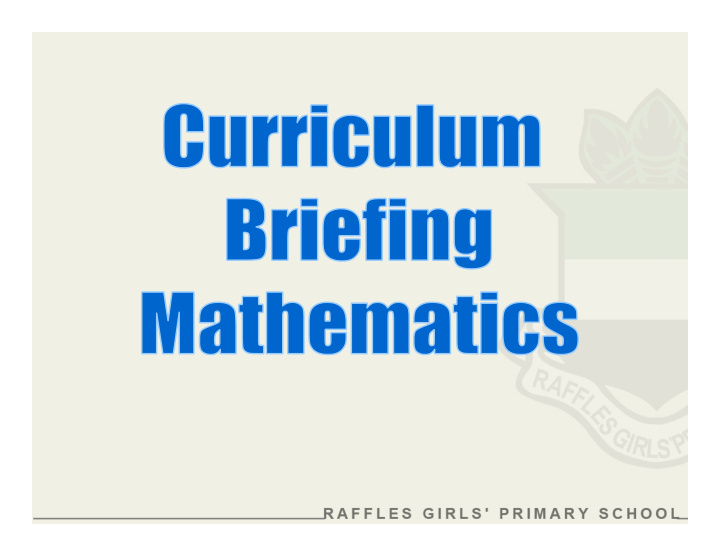



MOE Mathematics Framework (sets the direction for the teaching, learning and assessment of mathematics) Mathematical Problem Solving Concepts Mathematical problem solving is the central to mathematics learning. It involves the acquisition and application of mathematical concepts and skills in wide range of situations, including non-routine, open- ended and real world problems
Concepts • Numerical • Algebraic • Geometrical • Statistical Mathematical • Probabilistic Problem • Analytical Solving Use of manipulatives, hands- on activities and technological Concepts aids will be part of the learning experiences of the pupils
Skills • Numerical calculation • Algebraic manipulation • Spatial visualisation • Data analysis • Measurement • Use of mathematical Mathematical tools Problem • Estimation Solving The development of skills proficiencies in the pupils is Concepts essential in the learning and application of mathematics
Processes • Reasoning, communication and connections • Thinking skills and heuristics Mathematical • Application and Problem modelling Solving To develop a habit of mind through applications of mathematics in Concepts different contexts
Attitudes • Beliefs • Interest • Appreciation • Confidence • Perseverance Mathematical Problem Solving Making learning of mathematics fun, meaningful and relevant goes a long way to inculcating positive attitudes Concepts towards the subject
Metacognition • Monitoring of one’s own thinking • Self-regulation of learning Mathematical Problem To help pupils develop their problem solving abilities by encouraging Solving them to seek alternative ways of solving the same problem, allow Concepts them to discuss and explain how to solve a particular problem etc
Mathematics@P3 • New 2013 syllabus • Focus on the math language, reasoning, communication and connection • Wider scope and more depth
Topics in Primary 3 1) Whole numbers 2) Fractions 3) Length, Mass and Volume 4) Time 5) Money 6) Area and Perimeter 7) Perpendicular lines and parallel lines 8) Angles 9) Bar graphs
Whole numbers • Focus is on operation skills Adding on from P2: • Multiplication tables of 6, 7, 8, 9 • Long multiplication and division
Fractions Adding on from P2: • Equivalent fractions • Compare and order unlike fractions • Addition and subtraction of unlike fractions
Length, mass and volume Adding on from P2: • Conversion of units (e.g. m to cm, m to m and cm, etc)
Time • Measurement of time in hours and minutes • Calculate duration of a time interval
Money • Addition and subtraction of money in decimal notation
Area and Perimeter (new) • Concept of area and perimeter • Using formula to find area
Geometry (new) • Perpendicular and parallel lines • Identifying angles, right angles
Data Analysis Adding on from P2: • Bar graphs
Exam Format Time allowed: 1h 45 min Section A : MCQ (40 marks) 20 questions Section B : SAR (40 marks) 20 questions Section C : Word Problem (20 marks) 6 questions (3 and 4 marks)
How is assessment different in P3 • More lengthy word problems. • More steps involved in getting the answer • More challenging questions in the various section • Longer duration • SA1 testing up to the topic Money (3B)
In class… • 11 periods of Math per week • Completion of syllabus • Topical worksheets and tests • Depending on pace of class, enrichment may be done • Use of games to reinforce and teach selected topics
Other supplements in class • Focus on problem solving skills – Solve word problems – Non routine questions • Learning Solution in Mconline. For additional practice and reinforcement • Development of visual spatial skills
Sample of non routine questions Jenny had 30 chicks and ladybird beetles altogether. There were a total of 132 legs. How many chicks were there?
Sample visual spatial lesson You are given 7 numbers from a set of 0 to 9 number plates. Out of the 7 numbers selected, use only 6 to form a sum that gives maximum value. The 7 numbers are: 0 2 3 5 6 8 9 –
Points to note • the curriculum takes on a spiral approach. Some of the concepts taught are built on concepts taught in other years • Exams may test on topics taught in previous years.
How you can help your child? • Do go through the work we have done in class with your child. Let them try the word problems again. • Help them memorize their time tables by testing them occasionally – relate them to real life examples. • Encourage them to check their work for accuracy • Ensure that they do their homework. • Encourage them to approach their math teachers if they encounter difficulty in understanding. • Ensure that they have shown you their work and file it properly to facilitate revision.
Recommend
More recommend